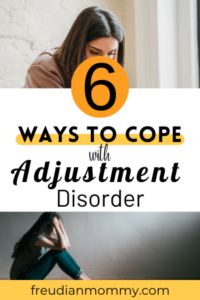Are you looking for ways to cope with an adjustment disorder that resulted from a recent significant change in your life?
If so, you are not alone. Many of us were given a plethora of coping skills to help us cope with life’s pressure from a young age; however, change and stress can be challenging.
When those coping skills fail to resolve our stressful state, adjustment disorder is imminent.
Not everyone who goes through a significant life change develops adjustment disorder because everyone handles stress differently. Some people have a much harder time adjusting to major life changes and stressors than others.

What is an adjustment disorder?
An Adjustment Disorder is exactly what it’s called, an adjustment—an adjustment to significant changes and life stressors.
Adjustment disorder is a short-term trauma and stress-related condition caused by a highly adverse reaction to one or more identifiable life stressors. Stressors typically include the death of a loved one, divorce, health issues, significant changes, sudden disaster, etc.
Also read: How to Recognize Major Depressive Disorder In Adults
Signs and symptoms of adjustment disorder:
If you have recently gone through a notable change in your life and have never been diagnosed with depression or anxiety, and you have been experiencing the following symptoms:
- Low mood
- Loss of interest in your favorite activities
- Tearfulness
- Feelings of hopelessness
- Sleep disturbance
- Fatigue or loss of energy
- Increase or decrease in appetite
- Nervousness
- Worry
- New and unusual destructive behavior
- Jitteriness
- Irritability
- Muscle tension
- Sleep disturbance (difficulty falling or staying asleep, or restless unsatisfying sleep)
- Recurrent thoughts of death (not just fear of dying), suicidal ideation or suicide attempts

You may be struggling with an adjustment disorder.
These emotional and behavioral symptoms occur within three months of a particular stressor and usually last no longer than six months without the stressor.
Types of adjustment disorder:
An adjustment disorder can be presented with:
- Depressed moods
- Anxiety
- Mixed Anxiety and Depressed mood
- Disturbance of Conduct
- Mixed with disturbance of emotions and conduct or
- Unspecified
Adjustment Disorder with Depressed Moods:
When adjustment disorder is experienced with depressed moods, you will experience more symptoms of depression like low mood and crying. However, your symptoms do not meet the criteria for being diagnosed with depression.
Adjustment Disorder with Anxiety:
You have more anxiety symptoms like worry and tension but do not meet the criteria for anxiety diagnosis.
Adjustment Disorder with Mixed Anxiety and Depressed Mood:
Your emotional response is dominated by both depression and anxiety symptoms but does meet the criteria for neither.
Adjustment Disorder with Disturbance of Conduct:
This emotional response is overshadowed by new and unusual dangerous or destructive behavior, such as fighting and reckless driving, but does not meet the criteria for conduct disorder.
Adjustment Disorder with Mixed with Disturbance of Emotions and Conduct:
This emotional response is mirrored by both emotions, and destructive behaviors like depressed mood, anxiety, fighting, yet do not meet the criteria for depressive disorder, anxiety disorder, bipolar disorder, or conduct disorder.
Unspecified:
In this instance, the adjustment is not characterized by one particular pattern, but the coping style is abnormal and concerning.
6 Ways To Cope With Adjustment Disorder:
1) Go to therapy:
Psychotherapy, also known as Talk therapy, is the most effective and recommended treatment for Adjustment Disorder. Because this disorder is only imminent when our coping tools fail to relieve us of the emotional baggage that resulted from a specific change or stressor, talking with a professional can help us develop new ways and solutions for this problem. Talking to a professional also enables you to make sense of maladaptive and distorted thinking and problem-solving.
2) Medication:
Sometimes talk therapy alone isn’t effective. If that is the case, medication can be added to your treatment plan. Reach out to your mental health and primary care provider for a medication evaluation if you feel that talk therapy is genuinely not helping you get better.

3) Decrease stressor:
Change and stressors like losing a loved one or ending a romantic relationship are not always in your control. However, if the added stressor is in your control, gradually incorporating the change into life can help minimize the likelihood of developing an adjustment disorder.
4) Surrounding yourself with your loved ones:
It can be tempting to isolate yourself when dealing with adjustment disorder, but encouraging yourself to reach out to people who care about you will be beneficial in the long run. Isolation leads to overthinking, which leads to negative thinking. The outcome of those two combinations can lead to something much more severe.
5) Maintain a healthy lifestyle:
Maintaining a healthy lifestyle will promote a positive change in your life. Do this by working out, eating healthy, keeping up your hygiene, and living in a clean environment. These activities are natural releasers of endorphins, a hormone that boosts pleasure and the feeling of well-being.
Also read: Grounding Techniques For Anxiety And PTSD
6) Engage in a positive social network:
Participating in a positive social network can help boost your mood by increasing your self-confidence and self-esteem and reducing loneliness. Engaging in a positive social network can also improve your overall quality of life. So go out to lunch or dancing with that friend you’ve been avoiding because you don’t “want them to see you in this condition.”
How to cope with Adjustment Disorder
Freudian Mommy’s References:
American Psychiatric Association. (2013). Diagnostic and statistical manual of mental disorders (5th ed.). Arlington, VA: Author.













